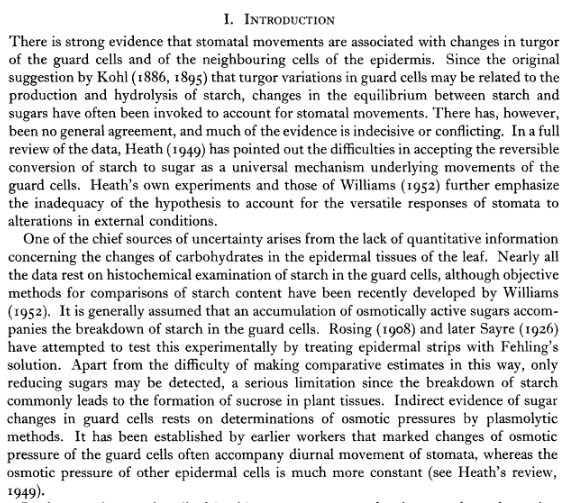==================
浇水初期会导致气孔关闭,光合作用和蒸腾速率降低,但随后叶片阻力减小,速率恢复正常,因为叶片内部的正常渗透关系重新建立起来。
Inicialmente, a irrigação leva ao fechamento dos estômatos, com taxas reduzidas de fotossíntese e transpiração, mas posteriormente a resistência das folhas diminui e as taxas aumentam à medida que as relações normais de turgor na folha são restabelecidas.
El riego conduce al cierre estomático al principio, con tasas reducidas de fotosíntesis y transpiración, pero posteriormente la resistencia de las hojas disminuye y las tasas aumentan a medida que se restablecen las relaciones normales de turgencia en la hoja.
=============
STOMATAL BEHAVIOUR IN RELATION TO RATES OF PHOTOSYNTHESIS AND TRANSPIRATION IN PELARGONIUM
Willis A. J., Balasubramaniam S. (1968)
===
New Phytologist 67(2): 265-285 – https://doi.org/10.1111/j.1469-8137.1968.tb06383.x –
https://nph.onlinelibrary.wiley.com/doi/abs/10.1111/j.1469-8137.1968.tb06383.x
Summary
An experimental procedure is described by which contemporaneous assessments of leaf resistance, rates of transpiration and of carbon dioxide exchange can be made on attached leaves. The relative humidity and carbon dioxide concentration of an air stream flowing into a leaf chamber are controlled, and of the outflowing stream monitored. The effects of light intensity and of water relations of the leaf were investigated with reference to leaf resistance and rates of transpiration and photosynthesis. In Pelargonium × hortorum quick stomatal opening in response to illuminatioxi was observed in plants which were not under water stress. On illumination of darkened leaves the rates of transpiration and photosynthesis were shown to rise rapidly, bearing a relation to leaf resistance, and indicating stomatal control of these processes. Over long periods of illumination water deficits develop, leaf resistance increases and rates of transpiration and photosynthesis decline. Typical findings of the levels of leaf resistance at a range of light intensities, and the corresponding values of transpiration rate and photosynthetic rate, are given.
The overriding importance of water deficit in influencing stomatal behaviour in leaves under substantial water stress is shown in a series of experiments. When water deficits are fairly small, the stomata of leaves open in response to illumination, but more slowly than those of leaves of well-watered plants; in leaves under water stress stomatal closure is also much accelerated on darkening. Under moderate water deficits, the stomata of leaves may open in response to light, but close again fairly quickly as the stress increases. Changes in rates of transpiration and photosynthesis parallel closely those of leaf resistance under these conditions. The effect of watering plants under water stress on leaf resistance and rates of gaseous exchange is shown in two experiments. The results indicate that watering leads to stomatal closure at first, with decreased rates of photosynthesis and transpiration, but subsequently leaf resistance diminishes and the rates increase as normal turgor relations in the leaf re-establish. Stomatal behaviour and control of rates of transpiration and photosynthesis are discussed, and the water relations of the leaf shown to be of critical importance in this connection.

You must be logged in to post a comment.